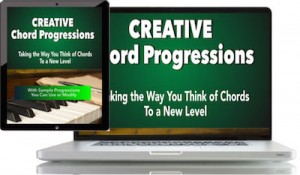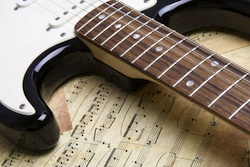Being imaginative with chord progressions is a good thing. But imaginative progressions need a harmonic goal.
__________________
 Download “The Essential Secrets of Songwriting” 10 e-book bundle, and build your audience base! Get today’s deal: A FREE copy of “Creative Chord Progressions” when you purchase the bundle.
Download “The Essential Secrets of Songwriting” 10 e-book bundle, and build your audience base! Get today’s deal: A FREE copy of “Creative Chord Progressions” when you purchase the bundle.
__________________
 Imaginative chord progressions are wonderful to experiment with, because chords that stray from the basic I-IV-V-I map often result in more creative melodies and a more imaginative approach to song structure. Problems can occur, however, when “imaginative” starts to equate to “random,” or perhaps even “nonsensical.” There is a way to become more creative with chord progressions while still allowing your music to sound structured and purposeful. It means two things: 1) shifting the harmonic goal to a new direction, and 2) using musical logic to make the shift.
Imaginative chord progressions are wonderful to experiment with, because chords that stray from the basic I-IV-V-I map often result in more creative melodies and a more imaginative approach to song structure. Problems can occur, however, when “imaginative” starts to equate to “random,” or perhaps even “nonsensical.” There is a way to become more creative with chord progressions while still allowing your music to sound structured and purposeful. It means two things: 1) shifting the harmonic goal to a new direction, and 2) using musical logic to make the shift.
First, let’s define those two terms, harmonic goal and musical logic.
A harmonic goal, at least in the pop song genre, means that you’ve appointed one chord as being the tonic chord, the one that serves as a home base. In a simple I-IV-V-I progression, the I-chord is the tonic chord. That means that most of the time, the chords you use will give a sense of musical tension as you move away from the I-chord, with that tension resolving as you move back toward the I-chord.
Musical logic means that every choice you make regarding your choice of chords is a choice that supports the key you were in, and/or can be seen to be in a new key. The spot at which that change happens usually connects with some degree of “smoothness” — a common tone, a common chord, or some other musical device.
When your chords, taken together, point to a harmonic goal, there is an important sense of strength and direction. Your music makes sense, even if the progression is complicated.
Here’s a list of five chord progressions that move through different tonal centres (i.e., they sound like they’re changing key), each change happening with a sense of musical logic.
- A Bm G C F Bb/D E A. You can see what strengthens this progression by looking at the bass line that’s created. There’s lots of bass line movement of 4ths and 5ths, which creates harmonic direction: G to C, then C to F, then F to Bb, etc. There’s nothing random here; each one of those pairs pulls the music in a new direction.
- A D C Am7 Bm7 C D G. This progression actually changes key so that while starting in A major, it ends in G major. The 3rd chord (C) is the one that pulls the music into a new direction. Listeners initially hear it as a lowered 3rd, but the Am7 confirms that a new key centre has been established.
- A F7 A/E B/D# D Gmaj7 A. What glues this progression together is the descending chromatic (i.e.,by semitones) bass line that happens between the F7 and the D: you get a bass line of F E D# D. Chromaticism is easy for the ear to follow, so any time you create complex progressions, you can help by inverting chords in such a way as to create a chromatic scale.
- A D Dm7 G C Cm7 F7 Bb. This progressions modulates upward by a semitone once it’s complete. If you want to get back to the original key of A major quickly, try following the Bb chord with a Bb/D (i.e., a Bb chord with D in the bass), then an E7, and back to A.
- A G A Em C F Am G C. This progression modulates from A major (actually A mixolydian), up a minor 3rd to C major. Like the first progression, following the C chord in the middle by F (a perfect 4th higher) solidifies the new tonal direction.
There’s no one right way to create complex progressions. All that really matters, in pop song genres, is that every chord you choose be seen to be in one key or another. You don’t even need to stay in any one key for very long. Two chords is enough. But simply randomly choosing chords can be detrimental to good song structure.
____________
Follow Gary on Twitter
 “The Essential Secrets of Songwriting” 10-e-book bundle will show you how to write great songs, harmonize your melodies, and give you hundreds of chord progressions in the process.
“The Essential Secrets of Songwriting” 10-e-book bundle will show you how to write great songs, harmonize your melodies, and give you hundreds of chord progressions in the process.
PURCHASE and DOWNLOAD the e-books for your laptop/desktop









